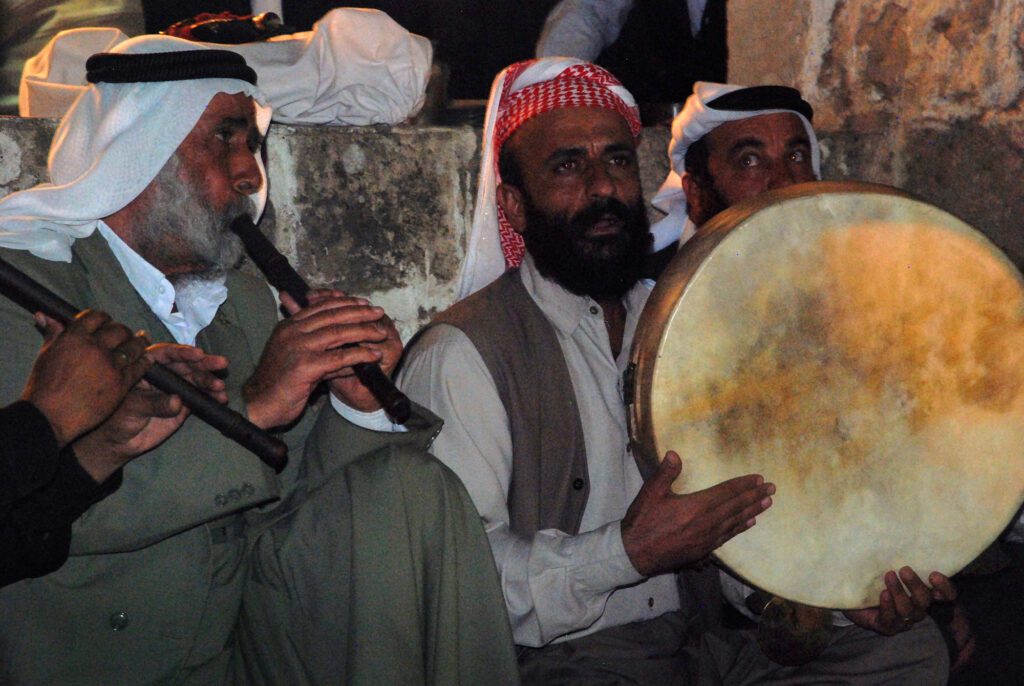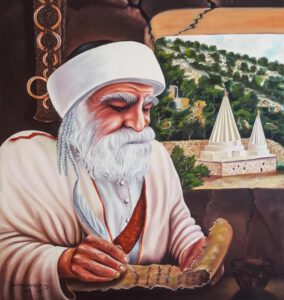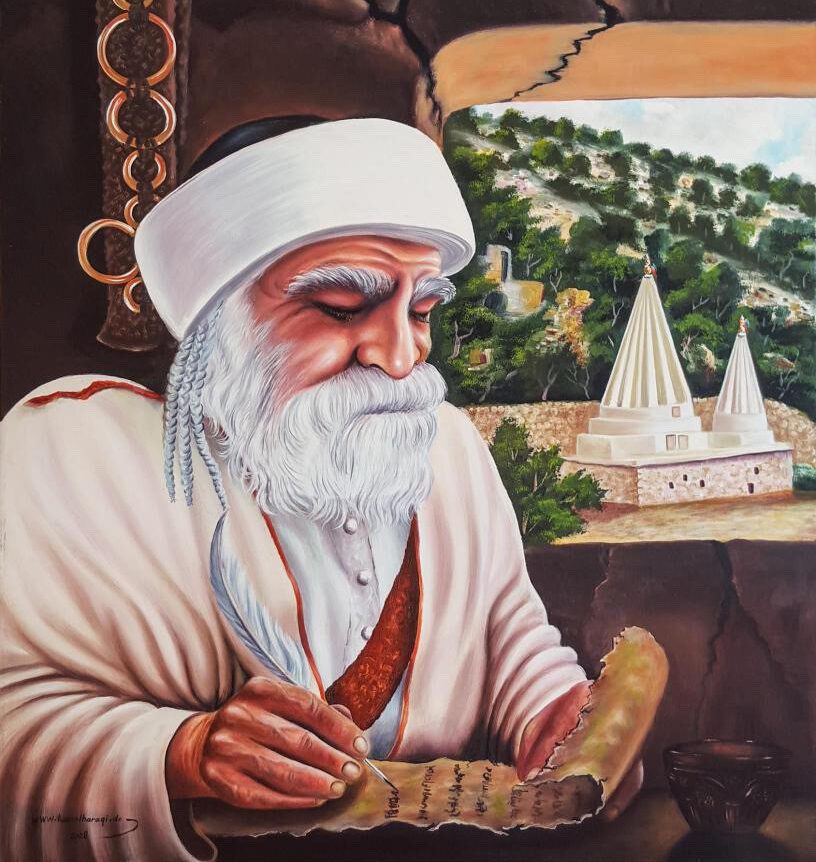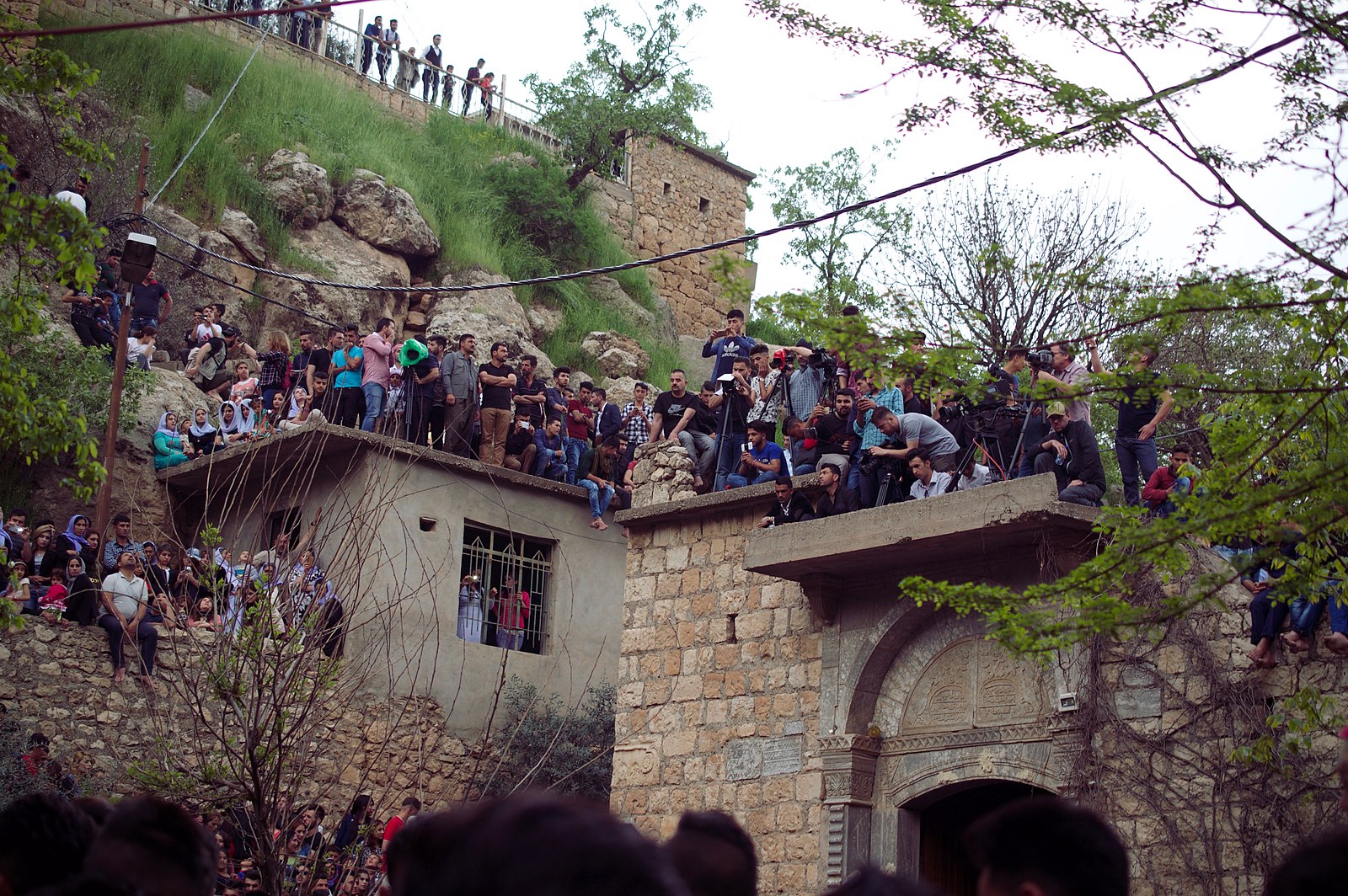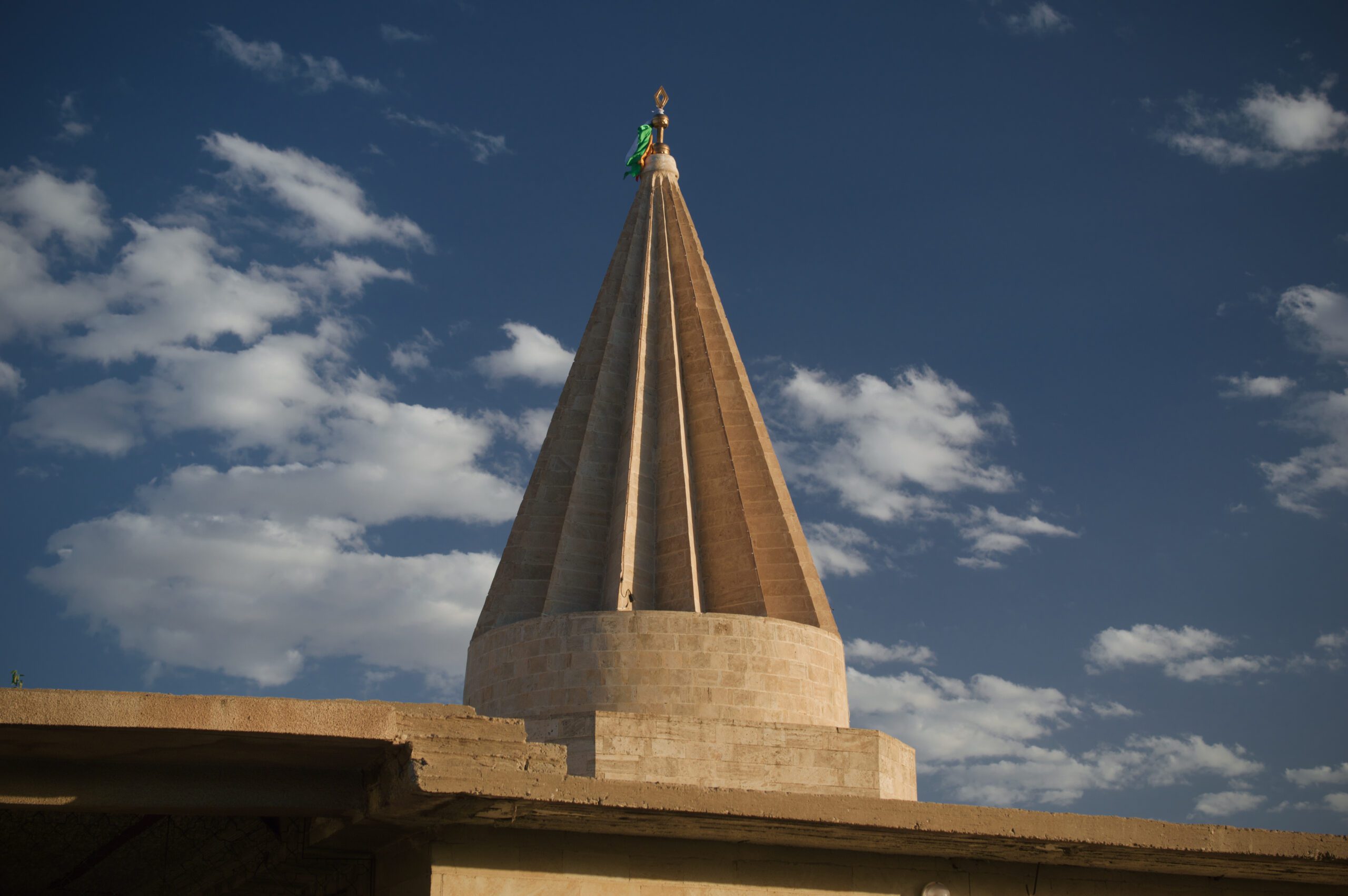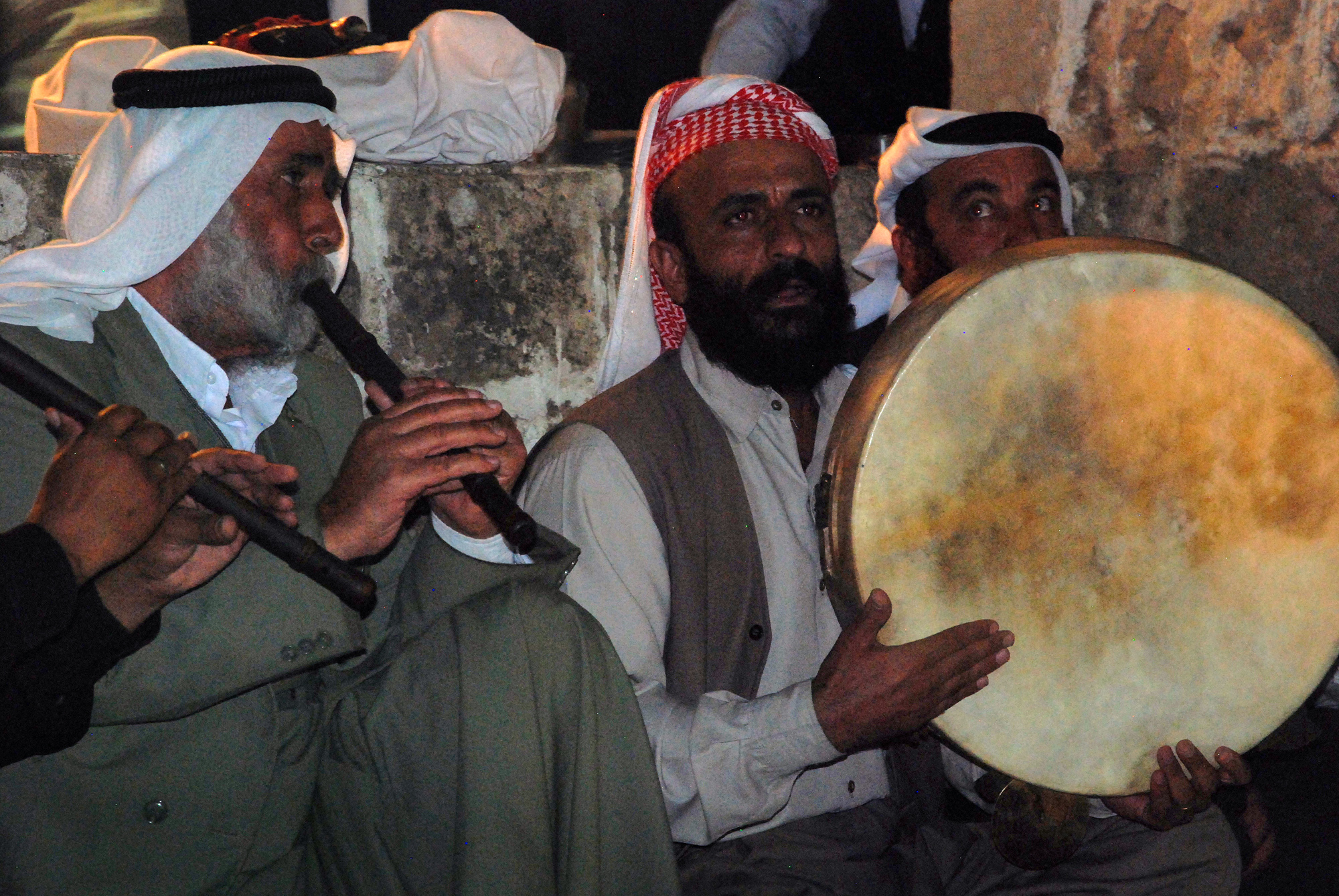Qewls – Religious Hymns
Qewls are religious hymns that occupy the highest position in the hierarchy of Ezidi religious literature. In Ezidi tradition, it is believed that the Qewls are of divine origin and composed by real historical saintly figures around the time of Şîxadî. They are called ‘the knowledge of God’ (‘ulmê Xwedê) or as a symbol of esoteric knowledge (‘ulmê batin), they are also called ‘the ocean’ (‘behr’) and ‘the heavy ocean’ (‘behrê giran’). Qewls are also characterized as ‘the sayings of God’ or ‘the sayings of Holy Men’ sent by God through these Holy Men to his people, who should follow these words. [1]Omarkhali, Khanna. (2017). “The Yezidi Religious Textual Tradition: From Oral to Written Categories, Transmission, Scripturalisation and Canonisation of the Yezidi Oral Religious Texts.” … Continue reading[2]Omarkhali, Khanna. (2012). “Yezidi Religious Oral Poetic Literature: Status, Formal Characteristics, and Genre Analysis: With Some Examples of Yezidi Religious Texts.” DOI: … Continue reading
It is believed that these Holy Men (Xas, Keremdar, Derwêş) had a divine power (‘keramet’) and possessed hidden (esoteric) religious wisdom. Notable authors of the Qewls include: Şêx Fexrê Adiyan (Şêx Fexredîn), Pîr Reşê Heyran, Derwêş Qatan, Babekirê Omerayê Zerzayî, Hesedê el-Tewrî, Dawidî bin Derman, Şêxûbekir, Dewrêşê Hebîb, Koçek Cem (Pisê Cemê), Derwêş Qotik, Şêx Havind, Derwêş Tajdîn, Ebûbekirê Cezîrî, Pîr Xidir, Gavanê Zerza, Lawikê Pîr, and Pîr Omerxala. There is no known fixed number of Qewls, but originally, 12,000 Qewls are believed to have existed during the period of Şêx Fexredîn, who is considered the author of the majority of Qewls. The number of Qewls is said to have decreased subsequently due to pogroms and genocides. [3]Ibid[4]Omerxalî, Xanna & Xankî, Kovan. (2009) “Metodeka analîza Qewlên Êzdiyan: Li ser mesela qewlê Omer Xala û Hesen Çinêrî.” Avesta Basın Yayın. pp. 22-23
Recitation of Qewls
In customary practice, the Qewls are transmitted orally by the learned or clerical members of the priestly castes of Şêxs and Pîrs, and in addition, there are certain roles associated with Qewl-reciting that can be attained by knowledgeable members from any caste, which are referred to by many terms, such as the Qewlzan (‘one who knows Qewls’), the Qewlvan (Qewl-bearer), the Qewlbêj (‘Qewl-singer’), who are also synonymously referred to as ‘ulimdar (‘a person who possesses [religious] knowledge’), ‘ulimbêj (‘a person who narrates religious knowledge’), oldar (‘religious man’) and zana (lit. ‘expert’, ‘erudite’, ‘a knowledgeable [person]’). Furthermore, the task of reciting Qewls is carried out by Ezidis who have attained high-ranking religious positions such as the Feqîr, the Micêwir (custodian of a shrine) and the Koçek (‘oracle’, ‘soothsayer’). The Qewal (‘reciters’), who are perhaps the most well-known for this task, are a hereditary group of performers of the Ezidi hymns. Qewals are from Mirîd caste and belong primarily to two tribes, the Hekarî and the Dumilî, although there also exist Qewals from Mamûsî tribe. The traditional center of the Qewals is considered to be the twin villages of Başîqa and Bahzan, but there also exists a section of Dumilî Qewals living in the town of Baedrê. [5]Interview with a native of Dumilî Qewal background from Baedrê village in Şêxan district, conducted on January 2023[6]Omarkhali, Khanna. (2017). “The Yezidi Religious Textual Tradition: From Oral to Written Categories, Transmission, Scripturalisation and Canonisation of the Yezidi Oral Religious Texts.” … Continue reading
Qewal schools in Bahzan, where children from the Qewal families were taught memorization of Qewls as well as performing of the sacred instruments Def and Şibab, operated actively in the mid-1920s. Between 1940s and 1963, religion classes were available in some Ezidi areas wherein Ezidi children would receive religious education from the erudite Ezidi religious men. Such education became unavailable after that during Ba’athist reign of Iraq until the year 1996, when the Ministry of Education of the autonomous Kurdistan Regional government officially authorized the inclusion of Ezidism classes within the school curriculum in the Ezidi-inhabited areas under the KRG administration. For the first time, school books on Ezidism were printed, which finally allowed the Ezidi pupils the right to study their own religion in their mother language of Kurdish. [7]Ibid. pp. 262-263[8]Shammo, Qader Saleem (2018). “Yezidis in Iraq: between citizenship and policies of marginalization (1958-2005)” pp. 102–105.

Melodies of Qewls & Occasions for Recitation
The melodies of the Qewls may vary from Qewl to Qewl, from reciter to reciter and from region to region; some Qewls are recited in a non-melodic manner at a fast speed or resembling natural speech, while some are recited in a melodic chant-like and hymnic manner each in their own unique and distinct melodies (‘kubrî’), of which many types exist. There are ‘kubrî’ that are characterized as ‘bilind’ (lit. ‘high’), ‘giran’ (lit. ‘heavy’) or ‘bi lez’ (lit. ‘quick’). Many of them are accompanied by music and the performance of two sacred musical instruments; ‘def’, a type of drum and ‘şibab’, a type of flute, which are played by Qewals in Lalish during every big festival. [10]Omarkhali, Khanna. (2017). “The Yezidi Religious Textual Tradition: From Oral to Written Categories, Transmission, Scripturalisation and Canonisation of the Yezidi Oral Religious Texts.” … Continue reading
Qewls are performed during all religious festivals and during both public and private gatherings and ceremonies, which include the following examples: [11]Ibid. pp. 145, 162-164
- Tawûsgêran ceremony (see below)
- During religious festivals celebrated in Lalish valley. Such as Çilê Zivistane (‘Forty [Days] of Winter’), Çilê Havînê (‘Forty [Days] of Summer’), and Cejna Cemayê (Feast of the Assembly), which takes place annually in Lalish from 6th-13th October. Five Qewals sit near the procession of Sema’ ceremony during Cejna Cemayê and recite the Qewls to an audience. Three of these Qewals who come from Dumilî tribe play the Def and recite religious hymns, while the other two who play the Şibab flute hail from Hekarî tribe.
- During local feasts, referred to as “Tiwaf” in Shekhan and “Cema” in Shingal. These feasts take place annually in the villages around local shrines throughout the spring season in Shekhan and during summer and autumn seasons in Shingal.
- During funerals (‘tazî’, ‘sermiriya’). Two or three people simultaneously recite Qewlê Seremergê together with other Qewls for a quiet audience. Among the Ezidis of Caucasus, this is usally done by a Sheikh and a Pir. In Iraq, when an Ezidi Sheikh of the priestly Adanî or Şemsanî clan dies, people ask an erudite religious man to perform a session of a sacred dance called Sema’ Miriya (Sema’ of the Dead) at their graves. For an Adanî Sheikh, “Sema’ya Şerfedîn û Şêx Hesen” is performed while for a Şemsanî Sheikh, “Sema’ya Şêx Şems” is performed. Sema’ sessions are always accompanied by recitation of Qewls.
- At the graves (‘ser mezela’) among the Ezidis in Armenia and Georgia. The performance is similar to that of funerals, in which an audience quietly stands around the grave while two or three priests are reciting Qewlê Şêx Hesenê Siltan e.
- During social gatherings in special gathering spots called ‘dîwan’ (lit. ‘assembly’), or among the Ezidis of Caucasus, ‘ode’ (lit. ‘room’) where Ezidis regularly gathered, discussed religion, exchanged news and solved issues in the community. In the past, Ezidi priests would discuss religious questions, and recite and interpret religious hymns in there while the laymen listened to them.
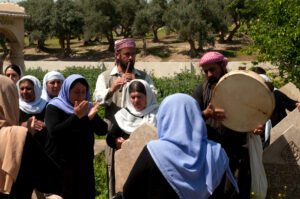
Qewals’ role in Tawûsgêran
Qewals are famous for their role in the ceremony of Tawûsgêran (Touring of the Tawûs), in which the sacred objects, called Tawûs (lit. ‘Peacock’) or Sencaq (lit. ‘banner’, ‘flag’, ‘region’ or ‘province’), which are bronze effigies bearing the image of a bird, are taken out and brought with Qewals out on their tours to the Ezidi communities in the regions that the Tawûs are assigned to. During the Tawûsgêran ceremonies, Qewals chant for the locals some religious hymns, which are accompanied by the performance of the sacred musical instruments, the Def and the Şibab. Sometimes the hymns are recited together with the local educated religious men. Qewals collect offerings from the faithful and teach young people some religious texts during their short stays, maintain ties between the Ezidi communities and share news among them. Originally seven of these effigies are believed to have existed, assigned to seven different regions within the historical Ezidi territory, listed as follows: [13]Aysif, Rezan Shivan, 2021, “The Role of Nature in Yezidism: Poetic Texts and Living Tradition” p. 212[14]Omarkhali, Khanna. (2017). “The Yezidi Religious Textual Tradition: From Oral to Written Categories, Transmission, Scripturalisation and Canonisation of the Yezidi Oral Religious Texts.” … Continue reading
- Tawûsa Enzel/Êzî: Welatşêx region – Laliş
- Tawûsa Şingalê: Şingal region
- Tawûsa Hekarê/Zozana: Historical region of Hakkari, which extended beyond the modern province of Hakkari to some areas in Duhok, Van and Şirnak.
- Tawûsa Welatê Xalta: Region encompassing Siirt, Batman, Diyarbakir and Mardin.
- Tawûsa Helebê: Aleppo and Afrin regions.
- Tawûsa Tewrêzê/Tebrêzê: Tabriz region.
- Tawûsa Misqofa: Originally Tawûsa Serhed, a region encompassing a vast area including the provinces of Van, Muş, Erzurum, Kars, Agiri, Bingöl and Igdir. Renamed to Tawûsa Misqofa (‘Tawûs of Moscow’) 200 years ago after the mass exodus of Ezidi tribes from these regions to the Russian Empire.
Today only three of these are known to remain up to the present-day, namely the Tawûsa Enzel, Tawûsa Şingalê and Tawûsa Misqofa, of which only the former two are used by Qewals during Tawûsgêran ceremonies,[15]Ibid whereas Tawûsa Serhedê/Misqofa has been entrusted to a family of Sheikhs of Şêxûbekir lineage from Sînekê village of Kars district, who have been safekeeping it since the beginning of 20th century. It is presently displayed at their household shrine in Jrarat village of Armavir province along with other sacred relics and objects which are referred to as Nîşan (lit. ‘sign’). [16]Omerxalî, Xanna, “Tawis (Senceq) di Ermenîstanê da’ (Tawis (Senceq) in Armenia), Laliş A 28, Duhok, 2008
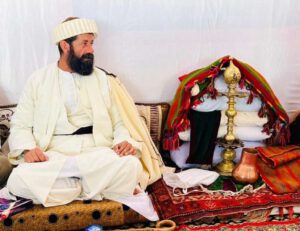
Language, Interpretation & Structure of Qewls
Qewls contain many allusive meanings and are composed in a poetic, complex and archaic form of Kurmancî Kurdish. There is a sizable presence of Arabic loanwords, typically derived from religious Sufi terminology, and at the same time, an abundant amount of old Kurdish vocabulary rarely used anymore in modern colloquial Kurmancî, are preserved and can be found in Qewls.[18]Amryan, T. (2018). ON ORIGINAL YEZIDI RELIGIOUS TERMINOLOGY. “Eighth International Conference on Iranian Linguistics (ICIL 8)” (Department of Iranian Studies of Yerevan State University, Yerevan)[19]Omarkhali, Khanna (2015). Rare Kurdish Words in the Yezidi Religious Hymns. Fu-berlin. (https://www.academia.edu/11502823/Rare_Kurdish_Words_in_the_Yezidi_Religious_Hymns) As such, it is the most difficult genre of sacred texts to understand and interpret for an ordinary Ezidi. To fully grasp the Qewls, one must be highly educated in Ezidi religion, possess a comprehensive understanding of Ezidi theology, be well-versed in Ezidi literature and know a native and sophisticated level of Kurdish as well as a good degree of Arabic, and some familiarity with the classical Persian and Turkic vocabulary which also make up a fraction of the vocabulary. [20]Omarkhali, Khanna. (2012). “Yezidi Religious Oral Poetic Literature: Status, Formal Characteristics, and Genre Analysis: With Some Examples of Yezidi Religious Texts.” DOI: … Continue reading[21]Omarkhali, Khanna. (2017). “The Yezidi Religious Textual Tradition: From Oral to Written Categories, Transmission, Scripturalisation and Canonisation of the Yezidi Oral Religious Texts.” … Continue reading
Accordingly, Qewls tend to be accompanied by other, more prose genres of Ezidi literature such as Dastan, Çîvanok and Çîrok (‘story, tale’), Mishabet (a sermon usually performed during large religious festivals by a Qewal who is referred to as ‘Sencaqbegî’) and forms of commentary such as “şîrove” (‘interpretation’), “pirs” (‘question’), “me’na” (‘meaning’) or “serhatî” (‘story, experience, adventure’), which act as text interpretation or as elaboration of the Qewl to help the listeners understand the content. In contrast to the hymnic genres, Çîroks are prosaic narrations told in colloquial, spoken Kurmancî that can be understood by ordinary Ezidis and do not contain any hidden and allusive meanings which can only be grasped by erudite religious men. Knowledge of Çîroks is available to all people in contrast to Qewls which are only transmitted by the priesthood and educated religious men. Çîroks can also be narrated by both men and women alike whereas Qewls are traditionally only recited by men, although women are also allowed to learn the Qewls. [22]Ibid. pp. 108-109, 111-113, 158-161
Qewls are structured in stanzas (‘sebeqe’), with each stanza typically containing three lines (‘mal’, ‘rêz’) or sometimes two, four, five, seven or even nine lines, and on the group of lines within the stanza, there are often although not always, patterns of rhymes (‘qafî’) on the end of each line:[23]Ibid. 93-97
1. Zebûnekî minî dil meksûre,
My poor one of broken heart,
2. Heke ji ba ‘eziz Melek Fexredîn bêtin destûre,
If permission comes from the Angel Fexredîn,
3. Em dê medeha deyn ji behrêd kûre.
We shall praise the deep oceans.
-Qewlê Zebûnî Meksûr
As such, the grammar of the Kurmancî of the Qewls does not always correspond strictly to the grammar rules of the colloquial Kurmancî. [24]Ibid. 95[25]Omarkhali, Khanna. (2012). “Yezidi Religious Oral Poetic Literature: Status, Formal Characteristics, and Genre Analysis: With Some Examples of Yezidi Religious Texts.” DOI: … Continue reading As an example, another stanza from Qewlê Padişa (Hymn of the Lord) says:
1. Padişê minî padişa,
O my King of all Kings,
2. Ewî çê kir çiya û deşta,
He created the mountains and the plains,
3. Ew neqaşê hemû neqşa.He is the planner of all plans.
-Qewlê Padişa
In colloquial Kurmancî, the second line would commonly be formulated as ‘Ewî çiya û deşt çê kir’. However, to maintain the end-rhyme in the stanza, the verb ‘çê kir’ has deliberately been transposed to a position before the direct objects, and ‘deşta’, the plural form of the word, has been employed as the final word. The sentences in the Qewls are constructed in a manner that prioritizes maintaining the end-rhyme patterns which can be attributed to the influence of musical or melodic elements within the performance of the Qewls that are important in helping with memorizing them, differentiating between the texts, and creating a solemn and sacral style of performance. [26]Ibid[27]Omarkhali, Khanna. (2017). “The Yezidi Religious Textual Tradition: From Oral to Written Categories, Transmission, Scripturalisation and Canonisation of the Yezidi Oral Religious Texts.” … Continue reading
Prior to the recitation of a Qewl, a formula is uttered that goes by “Bi destûrê Xwedê, Xudanê Destûrê,” which can be translated as “With the permission of God, the Owner of Permission.” After finishing the recitation of a Qewl, the performer concludes by uttering the phrase “Em kêm in, Xwedê yî temame,” which can be translated as “We are imperfect, God is perfect.” [28]Ibid. p. 95
Categories of Qewls
There are various groups of Ezidi Qewls, categorized by their function and content. Among them, the Berane Qewls (“Rams’ Qewls”; also called Qewlê Beranî or Qewlêt Beran) which are higher in status than other Qewls and are considered to be the most sacred and rich in content regarding the Ezidi religion and philosophy. A reciter of Qewls is not allowed to study a Berane Qewl if he does not already know a number of other Qewls, is not skilled at the interpretation of Qewls, and does not possess an expert level of knowledge about Ezidi religious texts. When he has attained basic knowledge, he goes to his Ezidi religious preceptor (‘hosta’) to study a Berane Qewl, which is only permitted after an examination, whereupon, if he passes and has been determined as a knowledgeable Ezidi, he is granted permission to study a Berane Qewl, which he learns by heart first before studying its interpretation. [29]Ibid. pp. 99-102, 153[30]Omarkhali, Khanna. (2012). “Yezidi Religious Oral Poetic Literature: Status, Formal Characteristics, and Genre Analysis: With Some Examples of Yezidi Religious Texts.” DOI: … Continue reading
There are other categories of Qewls which deal with different topics, such as the creation of the world (cosmogony), eschatology, hagiography (describing the lives of Ezidi saints), rituals (liturgy) and ethics. For instance, ‘Social Qewls’ (‘Qewlên Civatê’) and ‘Advisory Qewls’ (‘Qewlên Nesîhetê’), which are often performed at Ezidi social gatherings, are described as hymns that contain worldly advice (‘şîretên dinyayî’), dealing with friendship (‘hevaltî’), good-hearted people (‘însanê xêrxwaz’), the value of the neighbourhood (‘qîmetê cînariyê’), etc.[31]Ibid[32]Pirbari D.V., Mossaki N.Z. The Hymn of P’īr Dāwid (Qawlē P’īr Dāwid) // Pis’mennye pamiatniki Vostoka. – 2020. – Vol. 17. – N. 3. – P. 115-126. doi: … Continue reading[33]Omarkhali, Khanna. (2017). “The Yezidi Religious Textual Tradition: From Oral to Written Categories, Transmission, Scripturalisation and Canonisation of the Yezidi Oral Religious Texts.” … Continue reading
Recent forgeries
In modern times, a number of newly-fabricated and spurious texts and prayers of dubious origin have come to surface, and, in certain instances, even the contents of the authentic Qewls have undergone alteration and distortion so as to conform to specific, often nationalistic, political ideologies and agendas. These have been circulated in various magazines, academic articles and books.
Mela Xelîl’s collection
A group of inauthentic 8 Qewls and 1 Qesîde can be found in the 2004 work “Perin ji edebên dînê Êzdiyan” of a famous Ezidi scholar, Xelîl Cindî Reşo, who claims that these texts had been forgotten. He received them on 19 May 2001 and 10 June 2001 from Ehmed Mela Xelîl who also goes by the names “Ebû Dasin” and “B. Ş. Dilkovan” in his publications. These texts were as follows:
- Qewlê Mersûma Barî
- Qewlê Şêxê Sirrêm
- Qewlê Birhîm Pêxember
- Qewlê Nûh Pêxember
- Qewlê Melik Salim
- Qewlê Mûsa Pêxember û Xidirê Zînde
- Qewlê Pir Hemedê Boz
- Qewlê Mîr Mihemedê Kurdî
- Qesîda Şêx Cêncer
Ehmed’s father Mela Xelîl, a Muslim Imam, is alleged to have learnt these texts in 1928-1929 from Pîr Çerût, who at the time held the position of Babê Çawîş. However, there are some doubts among Ezidi religious scholars that these are authentic. In his work “Lalişname”, Bedelê Feqîr Hecî, the son of the late and prominent Ezidi religious expert Feqîr Hecî who was himself one of the pupils of Pîr Çerût, does a detailed critique of each of these texts and explains why he deems these texts as inauthentic.
Bedel reports that during his 1994 visit to Mela Xelîl, who had just returned from Iran, he did not hear Mela Xelîl once mentioning the texts he allegedly learnt from Pîr Çerût, although Mela Xelîl and Pîr Çerût were known to be friends. Bedel adds that none of Pîr Çerût’s other pupils, including Feqîr Hecî, a renowned Ezidi religious expert, have any knowledge of these texts. Furthermore, when Bedel inquired about these texts with other notable Ezidi religious scholars, such as Pîr Dima from Georgia and Merwan Babirî from Iraq, he found that neither of them had any knowledge of these texts.
Bedel also sceptically raises the question of how a Muslim Imam could have memorized texts that are unknown to any Ezidi dignitaries or religious experts in other parts of Kurdistan or in Armenia and Georgia. He also adds that intriguingly, despite hundreds of well-known and authentic Qewls existing, none are among this collection of Qewls that Mela Xelîl allegedly learnt from Pîr Çerût. Afterwards, Bedel, from his close analysis of the texts’ contents, words and style, concludes that each of these texts are fake and although they were clearly composed by someone who was familiar with Ezidism, certain features pertaining to their structure and diction unequivocally suggest that they do not originate from within the Ezidi tradition. [34]Bedelê Feqîr Hecî. “Lalişname (Lêkolîn – Têkist – Gotar)” (2019) pp. 12-27
Politically-motivated falsifications
Another set of texts have in recent times been fabricated for political reasons, typically to advance the integration of Ezidism within the context of Kurdish nationalism and fulfill some Kurdish nationalistic ideals regarding Ezidism, some of which include hailing Ezidism as the true and original religion of all Kurds and the supposition that it is an offshoot of Zoroastrianism. Among these newly-fabricated forgeries are some that were published by some Kurdish intellectuals, by some websites and also even by Ezidi cultural centers in Germany, most notably, through the Bielefeld-based magazine “Laliş” and the book “Êzdaname”. Among these texts are as follows: [35]Demir, Hayri. (2017). Qewl-Fälschungen. ÊzîdîPress. https://www.ezidipress.com/blog/qewl-falschungen/[36]Omarkhali, Khanna. (2017). “The Yezidi Religious Textual Tradition: From Oral to Written Categories, Transmission, Scripturalisation and Canonisation of the Yezidi Oral Religious Texts.” … Continue reading
- Qewlê Zerdeşt (Hymn of Zoroaster) published in “Êzdaname”
- Qewlê Pîrê Siba (Hymn of the Pîr of Morning) published on www.lalish.de website
- Qewlê Newroz (Hymn of Newroz) published in Êzdaname
- A variant of Qewlê Afirîna Dinyayê (Hymn of the Creation of the World) by Russian Kurdish-Ezidi intellectual Qanatê Kurdo
- Paşdua (The Prayer of Afterwards) by Kurdish-Muslim writer Celadet Bedirxan
To further complicate the issue, even some of the authentic and recognized texts have been altered. Most controversially, there have been attempts to replace the original term “Êzîdxan” in Ezidi texts with “Kurdistan” and change the sentences in a lot of passages to give them a different meaning. One such example can be found in Beyta (also considered Qesîda) Şerfedîn, a very popular religious song in which lines 1 and 3 of the following passage:
1. Şerfedîne dînê me ye
Şerfedîn is our religion
2. Şerfedîn mîre li dîwanê
Şerfedîn is the prince in the Assembly
3. Ciwabê bidene Êzîdxanê
Bring the message to Êzîdxan
4. Bila qayîmken Îmanê
Let them strengthen their faith
Were changed into the following:
1. Şerfedîne ji dînê me ye
Şerfedîn is from our religion
3. Ciwabê bidene Kurdistanê
Bring the message to Kurdistan
The oldest written falsification of this verse can first be traced back to Celadet Bedirxan, a well-known Kurdish nationalist figure, who on the 8th page of his booklet “Nivêjên Êzîdiyan” (Ezidi prayers) published in 1933, falsified the passage by replacing “Êzîdxanê” with “Kurdistanê”. His book also contains other texts and prayers that he distorted or even fabricated himself. This falsified version even got circulated within some Ezidi circles, reaching the point that this falsified version was even inscribed on some shrines. For instance, in the Ezidi village of Kiwex, located in Şirnak province, the following was inscribed on the shrine of Şerfedîn:
“ŞERFÊDINÊ JI DINE MEYE ŞERFÊDIN MIRE LI DIWENÊ XEBERÊ BIDIN KURDISTANÊ BILA QAWIN BIKIN VÊ IMANÊ” (Building dated 30.04.2015)
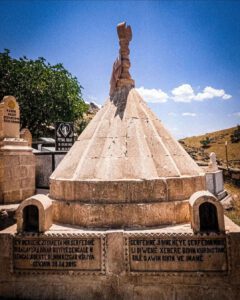
The falsification of Ezidi texts has generated opposition from many religious Ezidis, including prominent Ezidi intellectuals, traditional singers and religious scholars who denounced the falsified versions of the sacred texts and the newly fabricated Qewls. [38]The late Bavê Azad, a famous traditional Ezidi singer from the village of Êsiyan in Şêxan, called upon all new singers to use the correct version of Beyta Şerfedîn on the timestamp [12:14] of … Continue reading[39]Merwan Babirî (Merwanê Xelil), a renowned Ezidi religious expert and Qewlbêj, denounced the Qewls in the aforementioned list as fabricated in an interview with the Ezidi researcher Khanna … Continue reading[40]Dimitri Pirbari, a renowned Ezidi theologian and religious expert of Georgia, in an interview with the Polish researcher, Artur Rodziewicz, addresses the alteration of Beyta Şerfedîn and the … Continue reading
List of Qewls
The following is an alphabetical list of Qewls along with links to their corresponding transcriptions and translations, when available. Please note that this section is an ongoing project, and as our team continues to uncover additional Qewls, this section will be undergoing frequent updates and expansions.
References[+]
| ↑1 | Omarkhali, Khanna. (2017). “The Yezidi Religious Textual Tradition: From Oral to Written Categories, Transmission, Scripturalisation and Canonisation of the Yezidi Oral Religious Texts.” pp. 98-104 |
|---|---|
| ↑2 | Omarkhali, Khanna. (2012). “Yezidi Religious Oral Poetic Literature: Status, Formal Characteristics, and Genre Analysis: With Some Examples of Yezidi Religious Texts.” DOI: 10.31826/9781463235291-006 |
| ↑3 | Ibid |
| ↑4 | Omerxalî, Xanna & Xankî, Kovan. (2009) “Metodeka analîza Qewlên Êzdiyan: Li ser mesela qewlê Omer Xala û Hesen Çinêrî.” Avesta Basın Yayın. pp. 22-23 |
| ↑5 | Interview with a native of Dumilî Qewal background from Baedrê village in Şêxan district, conducted on January 2023 |
| ↑6 | Omarkhali, Khanna. (2017). “The Yezidi Religious Textual Tradition: From Oral to Written Categories, Transmission, Scripturalisation and Canonisation of the Yezidi Oral Religious Texts.” p. 139 |
| ↑7 | Ibid. pp. 262-263 |
| ↑8 | Shammo, Qader Saleem (2018). “Yezidis in Iraq: between citizenship and policies of marginalization (1958-2005)” pp. 102–105. |
| ↑9 | Please contact Robert Leutheuser at robleutheuser@gmail.com for permission for any and all uses |
| ↑10 | Omarkhali, Khanna. (2017). “The Yezidi Religious Textual Tradition: From Oral to Written Categories, Transmission, Scripturalisation and Canonisation of the Yezidi Oral Religious Texts.” pp. 92-93 |
| ↑11 | Ibid. pp. 145, 162-164 |
| ↑12 | Please contact Robert Leutheuser at robleutheuser@gmail.com for permission for any and all uses |
| ↑13 | Aysif, Rezan Shivan, 2021, “The Role of Nature in Yezidism: Poetic Texts and Living Tradition” p. 212 |
| ↑14 | Omarkhali, Khanna. (2017). “The Yezidi Religious Textual Tradition: From Oral to Written Categories, Transmission, Scripturalisation and Canonisation of the Yezidi Oral Religious Texts.” pp. 154-155 |
| ↑15 | Ibid |
| ↑16 | Omerxalî, Xanna, “Tawis (Senceq) di Ermenîstanê da’ (Tawis (Senceq) in Armenia), Laliş A 28, Duhok, 2008 |
| ↑17 | Attribution: Image courtesy of an anonymous owner |
| ↑18 | Amryan, T. (2018). ON ORIGINAL YEZIDI RELIGIOUS TERMINOLOGY. “Eighth International Conference on Iranian Linguistics (ICIL 8)” (Department of Iranian Studies of Yerevan State University, Yerevan) |
| ↑19 | Omarkhali, Khanna (2015). Rare Kurdish Words in the Yezidi Religious Hymns. Fu-berlin. (https://www.academia.edu/11502823/Rare_Kurdish_Words_in_the_Yezidi_Religious_Hymns) |
| ↑20 | Omarkhali, Khanna. (2012). “Yezidi Religious Oral Poetic Literature: Status, Formal Characteristics, and Genre Analysis: With Some Examples of Yezidi Religious Texts.” DOI: 10.31826/9781463235291-006 |
| ↑21 | Omarkhali, Khanna. (2017). “The Yezidi Religious Textual Tradition: From Oral to Written Categories, Transmission, Scripturalisation and Canonisation of the Yezidi Oral Religious Texts.” pp. 85-86 |
| ↑22 | Ibid. pp. 108-109, 111-113, 158-161 |
| ↑23 | Ibid. 93-97 |
| ↑24 | Ibid. 95 |
| ↑25 | Omarkhali, Khanna. (2012). “Yezidi Religious Oral Poetic Literature: Status, Formal Characteristics, and Genre Analysis: With Some Examples of Yezidi Religious Texts.” DOI: 10.31826/9781463235291-006 |
| ↑26 | Ibid |
| ↑27 | Omarkhali, Khanna. (2017). “The Yezidi Religious Textual Tradition: From Oral to Written Categories, Transmission, Scripturalisation and Canonisation of the Yezidi Oral Religious Texts.” pp. 92-93 |
| ↑28 | Ibid. p. 95 |
| ↑29 | Ibid. pp. 99-102, 153 |
| ↑30 | Omarkhali, Khanna. (2012). “Yezidi Religious Oral Poetic Literature: Status, Formal Characteristics, and Genre Analysis: With Some Examples of Yezidi Religious Texts.” DOI: 10.31826/9781463235291-006 |
| ↑31 | Ibid |
| ↑32 | Pirbari D.V., Mossaki N.Z. The Hymn of P’īr Dāwid (Qawlē P’īr Dāwid) // Pis’mennye pamiatniki Vostoka. – 2020. – Vol. 17. – N. 3. – P. 115-126. doi: 10.17816/WMO46774 |
| ↑33 | Omarkhali, Khanna. (2017). “The Yezidi Religious Textual Tradition: From Oral to Written Categories, Transmission, Scripturalisation and Canonisation of the Yezidi Oral Religious Texts.” p. 99 |
| ↑34 | Bedelê Feqîr Hecî. “Lalişname (Lêkolîn – Têkist – Gotar)” (2019) pp. 12-27 |
| ↑35 | Demir, Hayri. (2017). Qewl-Fälschungen. ÊzîdîPress. https://www.ezidipress.com/blog/qewl-falschungen/ |
| ↑36 | Omarkhali, Khanna. (2017). “The Yezidi Religious Textual Tradition: From Oral to Written Categories, Transmission, Scripturalisation and Canonisation of the Yezidi Oral Religious Texts.” pp. 154-155 |
| ↑37 | Please contact Abdulvahap Demir at v.demir4782@gmail.com for permission for any and all uses |
| ↑38 | The late Bavê Azad, a famous traditional Ezidi singer from the village of Êsiyan in Şêxan, called upon all new singers to use the correct version of Beyta Şerfedîn on the timestamp [12:14] of his following video: (2012, April 17). Bave Azad – şahse ezî/bayta şerfedin [OFFICIAL HD VIDEO 2012] [Video]. YouTube. (https://www.youtube.com/watch?v=CRS3W8MA3W4) |
| ↑39 | Merwan Babirî (Merwanê Xelil), a renowned Ezidi religious expert and Qewlbêj, denounced the Qewls in the aforementioned list as fabricated in an interview with the Ezidi researcher Khanna Omarkhali (See Omarkhali, K. 2017, p. 103) |
| ↑40 | Dimitri Pirbari, a renowned Ezidi theologian and religious expert of Georgia, in an interview with the Polish researcher, Artur Rodziewicz, addresses the alteration of Beyta Şerfedîn and the ideologically-motivated fabrication of some new texts such as Qewlê Zerdeşt (See: Rodziewicz, Artur. “Odrodzenie Religii Jezydzkiej W Gruzji? Rozmowy Z Dimitrijem Pirbarim, Głową Duchowej Rady Jezydów W Gruzji” (Revival of the Yezidi Religion in Georgia? Conversations With Dmitri Pirbari – the Head of the Spiritual Council of the Yezidis in Georgia.) |
